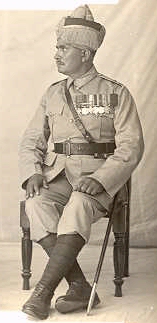Home
Page
Subedar Major Nausher
Khan, I.O.M.
King George's Own Sapper and Miners
(circa 1931)
by
Lieutenant Colonel Edward De Santis ©2008
Subedar Major Khan, a Muslim officer, is wearing
a khaki service dress and knickerbockers. He is wearing a brown
leather Sam Browne belt, leather sword slings, and dark blue
puttees. His sword is encased in a leather scabbard with metal
tip. Khan's paggari (or turban) is khaki with a gold fringe and
King George's Own Sappers and Miners cap badge of the Prince of
Wales plume design. He is also wearing unit shoulder titles and
his badges of rank on the shoulder straps of his tunic. The
Subedar Major is wearing the following medals:
1. Indian Order of Merit (I.O.M.)(2nd Class)
2. India Distinguished Service Medal and bar (1007
Havildar, 1st Sappers and Miners).
3 1914 Star and bar.
4. British War Medal.
5. Victory Medal with Mention in Despatches.
6. Coronation 1911 or Delhi Durbar 1911.
7. Russian Medal of St. George, 2nd Class.
Khan served as a Havildar in No. 4 Company, Bengal Sapper and
Miners in France and Flanders. He distinguished himself in action
at Festubert in December of 1914 when at great risk to himself he
stood in the open at Piquet House and directed the blocking of a
trench until he was severely wounded. Havildar Khan subsequently
won the I.D.S.M for services in Mesopotamia and was awarded the
Indian Order of Merit in 1919. The citation for his I.O.M. reads
as follow:
Awarded the Indian Order of Merit, 2nd Class
Jemadar Nausher Khan, I.D. S.M., 1st King George's Own
Sappers and Miners. For conspicuous gallantry and leadership
on the 19th September 1918, during the attack on the enemy's
trenches. He was in command of his section of sappers making a
gun road across "No Man's Land" and the enemy trench
system, under enemy shell fire, and carried-out his work so
efficiently that the road kept pace with the advancing infantry
and the artillery were able to advance immediately the infantry
reached their objective. He has displayed ability and power of
command on other occasions.
REFERENCES:
1. With the Indians in France, p.355.
2. SANDES, E.W.C. The Indian Sappers and Miners. The
Institution of Royal Engineers, Chatham, Kent, 1948, p.445.
3. Honours and Awards of the Indian Army, August 1914 - August
1921. J.B. Hayward & Sons, Ltd., p. 3 1. Originally
published in 1931 as the Roll of Honour. Indian Army- 1914-1921 9
Army Order 2078 of 1919.
